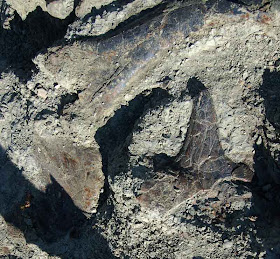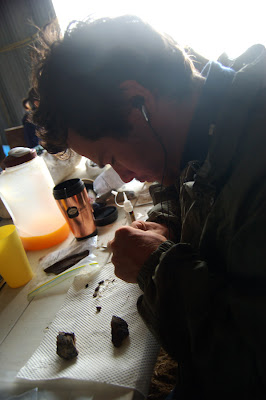The Late Permian herbivore Suminia and the early evolution of arboreality in terrestrial vertebrate ecosystems. 2009. Jörg Fröbisch1 and Robert R. Reisz. Proceedings of the Royal Society B.
In the Late Paleozoic (260 million years ago), long before dinosaurs dominated the Earth, ancient precursors to mammals took to the trees to feed on leaves and live high above predators that prowled the land. Elongated fingers, an opposable "thumb," and a grasping tail of Suminia getmanovi demonstrate that this small plant-eating synapsid is the earliest known tree-climbing vertebrate.
Suminia was relatively small, about 20 inches from its nose to the tip of its tail. The tree-climbing lifestyle of this Paleozoic relative of mammals is particularly important because for the first time in vertebrate evolution it gives access to new food resources high off the ground, and also provides protection from ground-dwelling predators. The evidence for this lifestyle is based on several excellent skulls and more than a dozen exceptionally well preserved, complete skeletons from a single large block of red mudstone that was discovered in central Russia's Kirov region.
The study also provides the first evidence in the fossil record of food partitioning between small climbing and large ground-dwelling plant-eaters and this happens shortly after the establishment of the modern terrestrial ecosystem with large numbers of plant-eaters supporting few top predators. Earlier terrestrial vertebrate communities did not have this modern hierarchy, but instead were composed of various-sized predators and relatively few plant-eaters, with most of the food resources being provided by insects and aquatic organisms. link.
Friday, July 31, 2009
Thursday, July 30, 2009
Southern Alberta Dinosaur Project Photos #4

Kentaro Chiba and Dr. Dennis Braman (Royal Tyrrell Museum) run a section through the McPheeters bone bed.

Some of the over 600 specimens collected this summer.

Tom Cullen (background; Carleton University) works the ceratopsian bone bed.

Chris from Carleton makes a point.

David Evans talks to kids at the Royal Ontario Museum via a satellite uplink from one of the bone beds. The ROM sent out 2 techs for a week to make sure that everything worked smoothly.

The helicopter lift of the Foremost hadrosaur.

Ryan Schott (U of Toronto) cooks up ribs while Tetsuto Miyashita catches up on field notes.

Evan Scott (CWRU) gives an evening seminar.

Part of the field crew in Orion (population: 4) where we get gas at Boyd's gas station.

Boyd Stevens pumping gas from his truck mounted tanks.

Boyd at work.
Friday, July 17, 2009
Southern Alberta Dinosaur Project 2009 Photos #3

The McPheeters Centrosaurus bone bed in the upper Oldman Fm.

Renee Beaton (Carleton U) maps the Centrosaurus bone bed.

Valley of the Cows

Centrosaurus nasal with horncore.

Bard McFeeters (Carleton U)(no relation to Bill McPheeters who found the site) helps Kentaro Chiba map.

Caleb Brown and Brian Matthews take a break.
Thursday, July 16, 2009
Southern Alberta Dinosaur Project 2009 Photos #2
Top row (L to R): Darren (U of Alberta), James Tikson (U of Toronto), Jamie Boyle (CWRU), Michael Ryan (CMNH), David Evans (ROM), Ian Morrison (ROM), Eric Snively (U of Alberta), Ryan Schott (U of Toronto), Brad McFeeters (Carleton U), Robin Sissons (U of Alberta);
Middle row: Larisa Hussain (U of Toronto), Kentaro Chiba (Hokkido U), Phil Bell (U of Alberta).
Bottom row (L to R): Lauren Scheneider (ROM), Renée Beaton (Carleton U), Jody Townshend (ROM), Tetsuto Miyashita (U of Alberta), Don Cretin, Brian Matthews, Cathy Falls, Caleb Brown (U of Calgary).
Previously in camp and missing from the photo: Marc Formosa, Brendan Polly, and Jessica Hawthorn (all U of T); Derek Larson (U of A).
Tuesday, July 14, 2009
Southern Alberta Dinosaur Research Project 2009 Photos
Sorry to have been out of touch. Once I got in the field a few weeks ago Google disabled my password for my account so it's taken me this long to sort things out.
Dr. David Evans and I, and our crew of techs, students, and volunteers have been hard at work on a number of sites despite cold weather and rain. I'll post some random images from the 1st few weeks of work now and get more up to date ones soon.

Camp at Cecil Nesmo's ranch.

Camp

Ian Morrison (ROM) and Kentaro Chida (Hokkido University)

The Zen of Kentaro

Dr. Evans (ROM) puts his back into it.

Brian Matthews, long time volunteer.

A break from overburden removal

The "McPheeter's" ceratopsid bone bed from the upper Oldman Fm.

Jamie Boyle (CWRU - Cleveland).
Dr. David Evans and I, and our crew of techs, students, and volunteers have been hard at work on a number of sites despite cold weather and rain. I'll post some random images from the 1st few weeks of work now and get more up to date ones soon.

Camp at Cecil Nesmo's ranch.

Camp

Ian Morrison (ROM) and Kentaro Chida (Hokkido University)

The Zen of Kentaro

Dr. Evans (ROM) puts his back into it.

Brian Matthews, long time volunteer.

A break from overburden removal

The "McPheeter's" ceratopsid bone bed from the upper Oldman Fm.

Jamie Boyle (CWRU - Cleveland).






